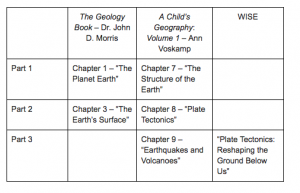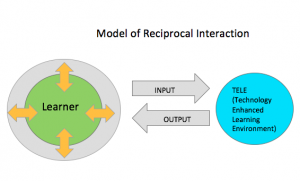Edelson’s (2001) writing on the framework of Learning for Use (LfU) model requires the teacher and learner to situate inquiry-based learning within a context of technology use and relevant future use. LfU is designed with three processes of learning, each incorporating the use of technology and causing the student to recognize the “usefulness of the content beyond the learning environment” (p.373). These three processes are defined as motivation, construction and refinement.
Edelson goes into significant depth about the LfU design strategies and elements contained within the Create-a-World Project, as well as a reasoning description of the purpose for including technology into the LfU model. For each strategy supporting a learning process, Edelson states the purpose behind the technology. These purposes include: a way of affording constructive learning , “improv[ing] upon the real world for discrepant events [i.e.] phenomena that are too small or too large, too fast or too slow, too hot or too cold for direct observation can all be reproduced using recording or simulation technologies” (p.376), offering students participation in “guided discovery by allowing them to conduct investigations with data … [and] by providing simulations of physical phenomena that students can directly interact with” (p.377). Furthermore, technology provides “[t]he ability to present information in a wide variety of formats … [i.e.] text, graphics, audio, and interactive computational objects” (p.378) as well as support the act of record keeping during inquiries for student reflection. Edelson’s intentional use of technology within the LfU framework, offers a standard for designers when considering the inclusion of technology within a learning framework. Does the technology enhance knowledge construction by affording practical tools for inquiry? Edelson’s inclusion of technology is extended in necessitating use and application: “Because knowledge application requires meaningful, goal-directed tasks, the technologies that can support knowledge application are the technologies that will allow learners to conduct meaningful tasks” (p.380).
Within both Edelson’s example of students using Create-a-World Project and Perkins, Hazelton, Erickson and Allen’s (2010) study on students using a GIS (Geographic Information Systems), there is a connection to what David Sobel (2004) refers to as place-based learning. Sobel describes place-based education as “the process of using the local community and environment as a starting point to teach concepts … emphasizing hands-on, real-world learning, enhanc[ing] students’ appreciation for the natural world, and creat[ing] a heightened commitment to serving as active, contributing citizens” (Sobel, 2004).
The connection between LfU and place-based learning is worth consideration as GIS tools afford the opportunity for students to interact initially within their community and then beyond. Interestingly, the practice of place-based learning is promoted within the BC Ministry’s curriculum in relation to indigenous learning. Combining place-based learning with GIS tools offers opportunity for indigenous and western learners to gain a deeper understanding of their local world, and intuitively of the world beyond them. Inquiries related to physical environmental changes, population increase or decline of species, migration patterns and weather patterns are all relevant areas of situated learning for both indigenous and western learners.
In Perkins’ et al (2010) study, there is support for the inclusion of place-based learning with GIS tools as middle school students participate in mapping their school yard using My World GIS curriculum. Perkins et al (2010) find a significant increase in students’ spatial skills after only three days of working with the GIS and GPS tools. They partially attribute this increase in skills to the inclusion of place-based learning: “Introducing GIS and GPS in the students’ familiar and immediate surroundings more easily bridges the gap between the real and digital worlds. Each student has tangible experience with their schoolyard and, therefore, some sense of that space that will allow them to construct new knowledge in the context of a place that they know”(p.217).
In closing, the LfU model requires highly structured inquiry-based processes such as “hypothesizing, collecting and evaluating evidence, and defending conclusions based on evidence” (Edelson, 2001, p. 362). Furtak (2006) describes guided scientific inquiry as inquiry when the teacher knows the answer, but is cautious with the power of suggestion. In Linn, Clarke and Slotta’s (2003) article on WISE, a more structured approach to inquiry is also suggested: “If inquiry steps are too precise, resembling a recipe, then students will fail to engage in inquiry. If steps are too broad, then students will flounder and become distracted. Finding the right level of detail requires trial and refinement and, in some cases, customization to local conditions and knowledge” (p.522). Through the explorations of various technology-based inquiry environments, it is evident that the teacher and/or designer is an expert in processes and in content, allowing for processes of inquiry to be experienced and developed, while supporting inquiry problem-solving and refinements through in-depth knowledge of content.



